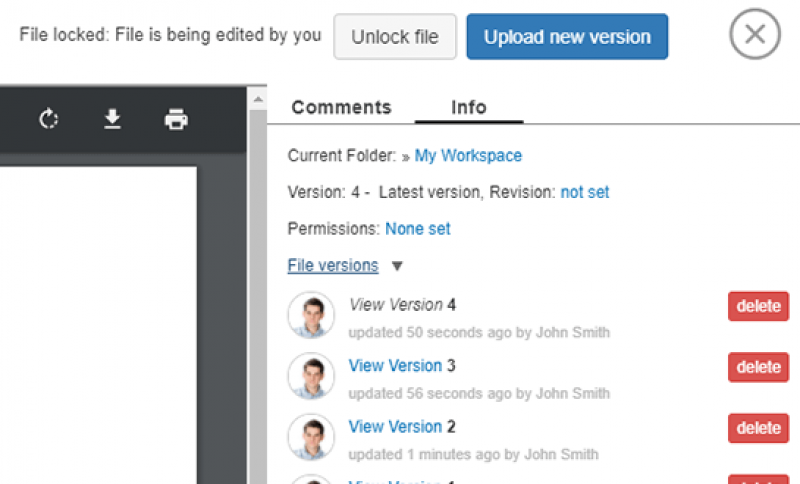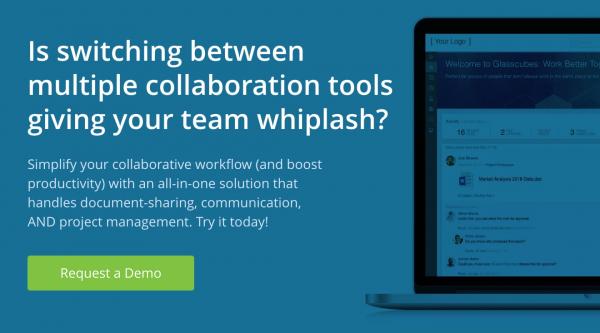10 Document Management Best Practices For Your Organisation
on 14 July 2022
Every organisation generates documents as part of doing business. Organisational growth compounds the number of forms, reports, and spreadsheets, all of which can quickly become a headache in the absence of a formal document management program.
Having a document control strategy that dictates the capture, storage, retrieval, coordination, and control of documents is essential to compliance and operational excellence. (Tweet This!)
Faith Kubicki, content marketing manager at IntelliChief, describes how the concept of business document management evolved. It first applied to simple storing and organising of documents in an electronic archive, which enabled faster retrieval and fewer paper costs. “Recently, the focus has become broader. Companies don't just want a digital storage system—they want to automatically collect data from those documents, sync that data across multiple systems, and simplify collaboration.”
This broadening of demands has driven the need for well-considered document management best practices. We reached out to several experts experienced with this function and garnered their input. A quick review of what they shared will help you determine whether your organisation’s efforts are on the right path or leading you into troubling territory.
10 Document Management Best Practices
1. Establish clear ownership of the document management program.
While a team or formal committee may be involved, your document management efforts won’t go far without assigning an accountable individual to lead the charge. Ideally, this person needs to have authority and influence over practices, personnel, and funding—such as a senior manager. This is because the assigned person must have the power to ensure compliance with internal policies, and external legal requirements and regulations.
Assigning one person of ultimate authority is also important for the bottom-up perspective. “If workforce members don’t know who to turn to for questions and concerns regarding document management, they won’t ask anyone. Instead, they’ll create ad-hoc workarounds in established document management processes, resulting in inconsistent and potentially undesirable outcomes,” warns Andrew de Bray, managing director of Factum Ltd.
2. Give proper time and attention to your document retention policy.
Andrew Schrage, CEO and cofounder of Money Crashers, advises, “One of my most-shared document management principles is setting a time frame for how long documents should be kept before they're destroyed or discarded. Just make sure you're following all relevant compliance requirements. This allows for more efficient document organisation and can assist in tracking.”
As Schrage alludes to, how long documents should be retained is typically determined by regulatory requirements. For example, you may be required to retain company financial reports for X number of years.
However, other business drivers also come into play, such as legal and operational concerns. For example, if there is a disagreement about a contract between you and a client or vendor, you’ll need to retain all documents related to that contract to support your legal defense. Considering your operations, guidance documents such as procedure manuals and engineering drawings may be retained for later reference and comparison even after they have been superseded.
To determine what documents should be retained, first you must properly evaluate and classify them, as Sophie Mills, CEO & Co-Founder of elMejorTrato.com, explains. “Document classification is something that must be performed by interdisciplinary teams. Otherwise, you won’t get enough perspective or context, resulting in ambiguous document types and future user confusion. Here’s an example: The sales team creates many different types of proposals, inspiring them to request several sub-classifications for these documents. However, if the document management team handles classification without cross-functional input, aspects like this will be missed.”
3. Get user input on document-related processes.
Senior leaders know what results they want from processes, but they aren’t always clear on how those processes should be developed. The ins and outs of everyday workflows require hands-on knowledge, experience, and lessons learned from the people who participate in them.
Kubicki emphasises how important user input is to developing effective processes that generate consistent results: “It's important to make a document management project a collaborative effort. Have your end users map out their document-based processes. CTOs, CFOs, and IT managers all bring important insight to the table, but process owners make the biggest difference. They may have specialised approaches for managing their documents in their day-to-day workflows, and these approaches may not be documented formally. They're the ones who will be able to best explain how things are done, and what features are needed and automated workflows should look like in a document management system.”
Does your company need a document specialist? See how these business leaders are taking advantage of this unique role.
4. Maintain consistency in folder structures and file names.
“Employees create dozens, hundreds, and sometimes thousands of files and folders every day, and they frequently use their own file names and folder structures,” says Benjamin Stenson, CEO of Norsemen Home Remodeling. “Undoubtedly, there will be issues because of this. When it comes to naming structures, some people may lose track of their original ones or are unaware of the best ways to file their paperwork.”
Stenson says that’s why it's important to build a framework for good document management by establishing proper naming conventions and standards. There is no universal solution, only what works best for you and your team. “For example, you can create an instructional document that informs all employees of the proper naming conventions of different types of files. This will help maintain uniformity and consistency with files.”
5. Set objectives and develop key metrics.
Sumit Bansal, CEO of Trump Excel, says one of his most recommended document management best practices is to set clear objectives around the practice. Not enough businesses make the effort in this area, nor do they identify how to monitor progress toward these achievements.
Bansal advises being specific. Are you aiming to make it easier for people to discover documents? Save on document storage costs? Improve collaboration? “Specify the metrics and key performance indicators (KPIs) you will use to assess progress toward your objectives, and establish a baseline so you can benchmark before implementing a document management solution.”
6. Determine which parts of your organisation will use the system.
Before building a document management system (DMS), or purchasing one, recognise that not all departments or functions will use it. Kubicki notes some considerations in making the determination. “There are actually quite a few areas where automated document processing can make a difference—from accounting to customer service to HR. Companies need to take the time to think through where they want to implement the solution and how implementing it will impact that function, then use that knowledge to guide their transition.”
7. Ensure your document management system is secure.
Even if a document management system eases your operational burden and helps with retention compliance, if it isn’t secure, you’ll face other problems. The system needs to be able to limit document access and provide clear audit trails, among other security features.
Kubicki notes how important specificity is when it comes to document management security: “Have your IT team get specific with data security requirements. In today's world, corporate data security is more important than ever. Companies need to be able to specify who can access what information and from which devices.”
Sensitivity of data is also a consideration. The system may need more robust capabilities. “When sensitive data is involved, there needs to be a way to redact it on an as-needed basis. There are also numerous security considerations—like SSL technologies, directory authentications, and TLS protocols—to make sure that documents are only viewed by authorised individuals. An added consideration: Companies that have lifecycle management regulations may want a solution that can automatically delete documents from their database once they are no longer needed. This way, they don't have to worry about maintaining a document destruction schedule or facing fines if they don't meet industry requirements,” she details.
Is document security a concern for your organisation? Not with Glasscubes. Request a guided demo of Glasscubes today.
8. Recognise what efforts are needed before implementing a document management system.
Mills cautions that a document management system by itself is not the answer. Companies must first create a solid foundation before considering which DMS to move forward with. “Many companies are in the process of acquiring and implementing a document management system (or have already done so), without first developing a robust document control strategy and program,” she explains.
Mills adds that raising awareness among, and getting feedback from, soon-to-be users is also important, as they play a key role in determining whether the system is a success. She also shares her recommended approach: “First, organise and categorise your documents. Second, develop your document strategy, including defining document policies and procedures. Third, get user feedback. Finally, define your requirements and start the software selection process.”
9. Be willing to change your document management system.
Schrage offers an important reminder about DMSs after implementation: “When it comes to document control best practices, you can’t stay stuck in the past. Ensure that your business needs are being met with your document management system continually, or you might want to look elsewhere. There's no reason to keep using a system that doesn't satisfy your needs.”
10. Rethink your document management processes to maximize efficiency.
“Many businesses make the mistake of simply recreating their paper-based procedures in a digital environment, rather than seizing the opportunity to rid themselves of unnecessary steps,” says Scott O’Brien, head of sales at PPC Ad Lab. “Instead of imitating paper-based procedures, improve them. Ask yourself why you followed a given method in the past and whether those activities are required in this new digital environment.”
O’Brien points to an example of a state government agency that wanted to digitise its buying approval process. Initially, it replicated the paper-based version, which required the assistant comptroller to collect and route approvals at each level. “Through the incorporation of business rules into its document management system, the agency was able to route bills for approval without requiring a gatekeeper at each step. This freed up time for the assistant comptroller and prevented bottlenecks.”
Make document management hassle-free with Glasscubes.
Glasscubes provides organisations like yours with a robust document management platform, while also enabling collaboration. With Glasscubes, you can create a centralised, go-to file repository so that all your documents are in one place—with no restrictions on the types of files you can store or on individual file sizes. There’s also automated version control for every document uploaded, ensuring users always have the latest and most accurate information.

We also ensure our platform is completely secure. For one, we maintain our ISO/IEC 27001 Information Security Management Systems certification (accredited by UKAS) and Cyber Essentials certification (accredited by IASME Consortium). In addition, we employ SSL encryption for data transfers and at-rest data encryption for all client files and information.
Get the comprehensive SaaS solution that fully enables document management and collaboration—from file sharing to communication and more. Request a guided demo of Glasscubes today.


